Girolamo Savonarola's denunciations of luxury during the Renaissance drew the ire of the Catholic Church, which had him excommunicated, tortured, hanged, and burned in 1498.
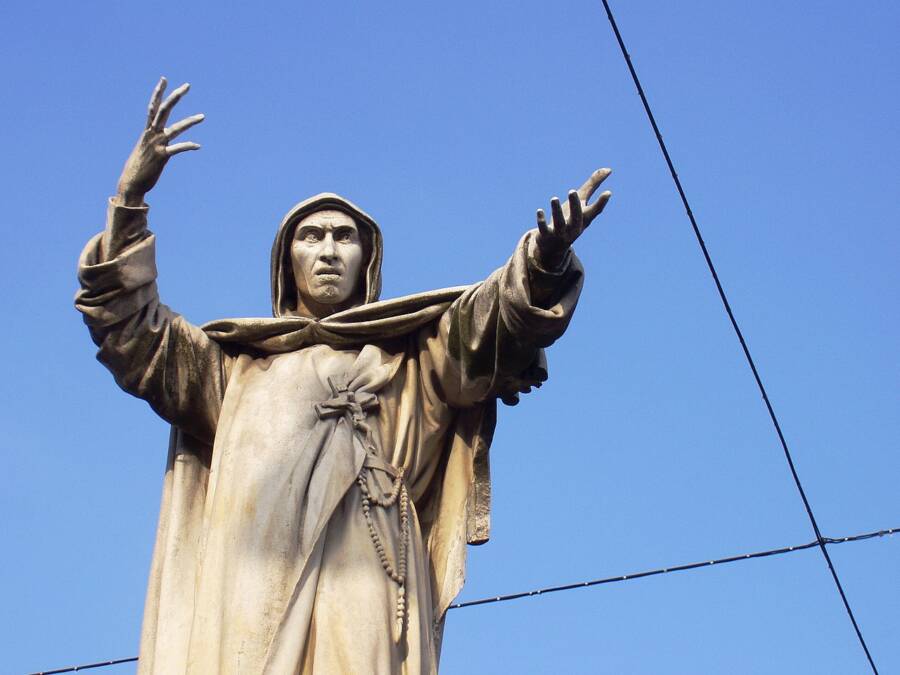
Daderot/Wikimedia CommonsA statue of Girolamo Savonarola in Ferrara, Italy.
Just the word Florence evokes a world of art, and power, and beauty. The Italian city was the cradle of the Renaissance, and hosted such masters as da Vinci, Michelangelo, and Botticelli. But one man saw all this wonder and wanted to watch it burn: Girolamo Savonarola.
Hailed by some as a prophet — and others as a fanatic — the Dominican friar embraced extreme asceticism and encouraged the luxury-loving Florentines to burn their treasures in his infamous “Bonfire of the Vanities.”
For a brief moment, Savonarola succeeded, temporarily turning the hedonistic city of Florence into a theocracy of his own making. But he drew the ire of the Catholic Church, and ultimately met a fiery end.
Girolamo Savonarola’s Righteous Path To Florence
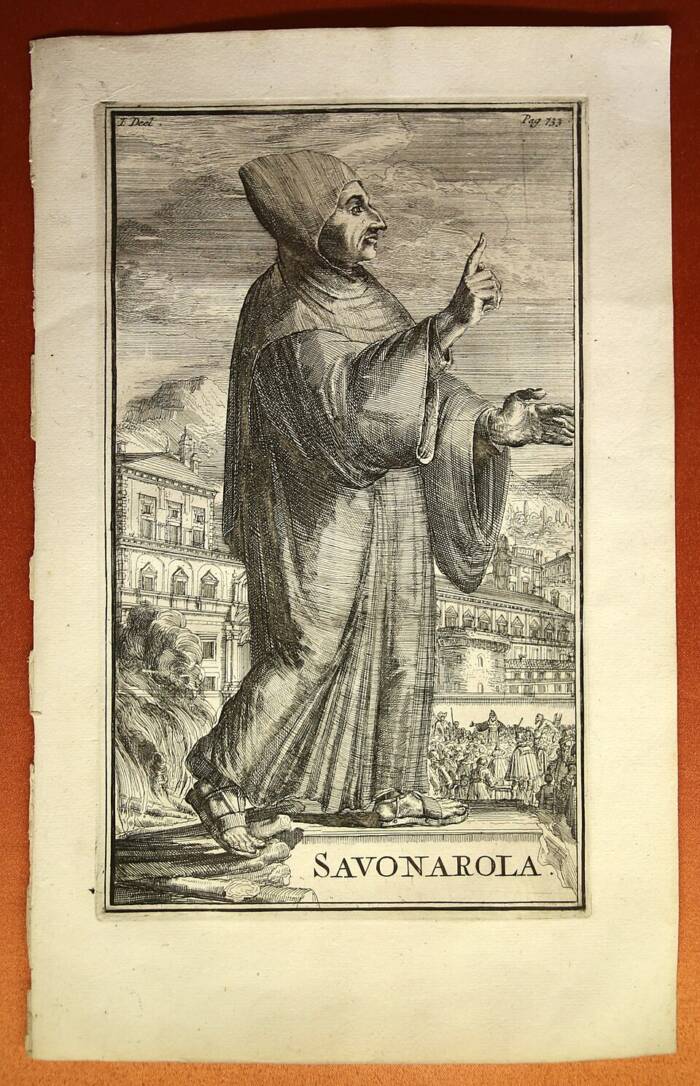
Museo nazionale di San Marco A depiction of Girolamo Savonarola.
Born on September 21, 1452, in Ferrara, Italy, Girolamo Savonarola came into a world seized by the humanist ideas of the Renaissance. But Savonarola had little taste for them.
By 1472, he had written an unfinished treatise entitled “On Contempt for the World.” By 1475, he had left his family home to enter the Dominican order at Bologna, and went on to teach Scripture. At one point, Savonarola wrote to his father condemning “the blind wickedness of the peoples of Italy.”
Then, in 1482, Savonarola was sent to the Convent of San Marco in Florence, where he steadily drew attention for his fire-and-brimstone sermons. Girolamo Savonarola drew heavily from Revelations, spoke of a new, imminent Biblical flood, predicted the deaths of Lorenzo de Medici, the de facto leader of Florence, and Pope Innocent VIII, and warned that an invader would soon cross over the Alps and attack Italy.
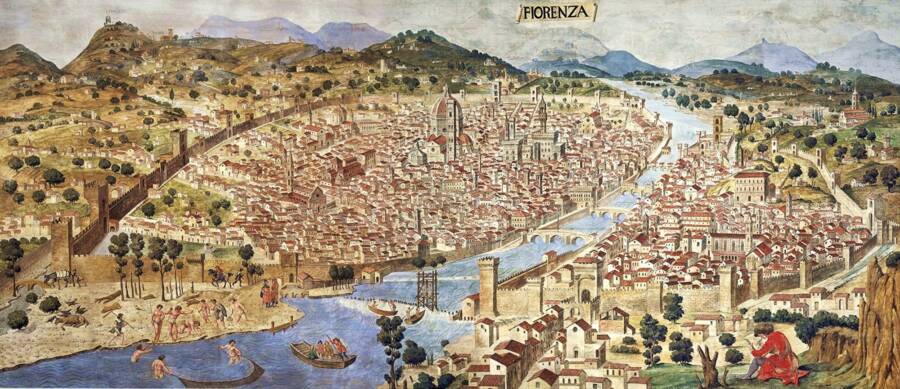
Public DomainFlorence in the 15th century.
Some of his prophecies seemed to come true. Both Lorenzo de Medici and Pope Innocent VIII died in 1492. And in 1494, King Charles VIII of France invaded Italy, prompting the remaining de Medicis to flee.
Into this power vacuum stepped Girolamo Savonarola, who sought to transform Florence into a new Christian republic.
The Attempt To Turn Florence Into A Christian Republic
Though Savonarola never held political office, he held incredible sway over the people of Florence in the absence of the de Medici family. Some even welcomed the friar as he set out to turn Florence into a “New Jerusalem.” Indeed, some of Savonarola’s initiatives were positive for the city, as he set out to feed the hungry, curb unemployment, and lower taxes.
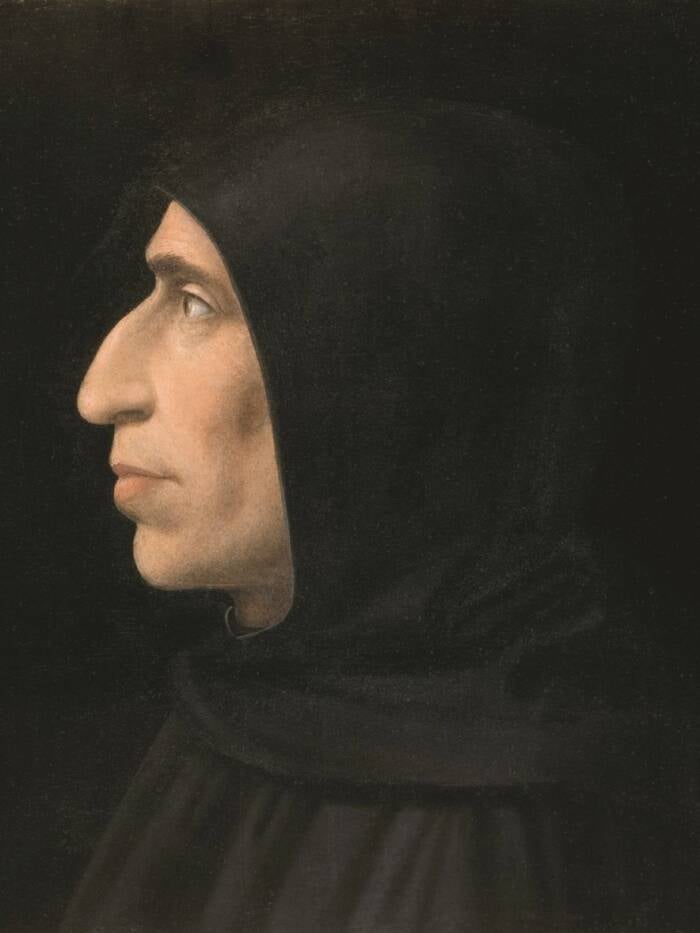
Museum of San MarcoSome of Girolamo Savonarola’s initiatives were popular — and some were not.
But many others watched with alarm as Savonarola used the Gospel to craft laws in Florence. Savonarola disliked jokes, poetry, and sex, denounced nude paintings and humanist ideas, and canceled the city’s popular carnivals and festivals. According to Smithsonian Magazine, his powerful sermons may have even driven Sandro Botticelli to burn some of his work (though fortunately not his famous “Birth of Venus”).
In a dark foreshadowing of the Hitler Youth, Savonarola also organized poor young boys into a sort of informal army. The youths were tasked with marching around Florence, keeping an eye out for any rule-breaking.
But Savonarola’s most infamous moment came on Feb. 7, 1497, when he threw his infamous “Bonfire of the Vanities”. In the Piazza del Signoria, Savonarola had a great pyre erected as his loyal youths went door to door, demanding that Florentines give up objects of “vice.” One remembered that the boys took “lascivious pictures… women’s hats, mirrors, wigs, dolls, perfumes, pictures in intarsia, sculptures, cupids, playing cards, dice boards, chess pieces, lutes and other musical instruments, books of diverse poets…”
These items were thrown onto the pyre — and set on fire. “With the greatest of happiness,” one witness remembered, “they burned everything.”
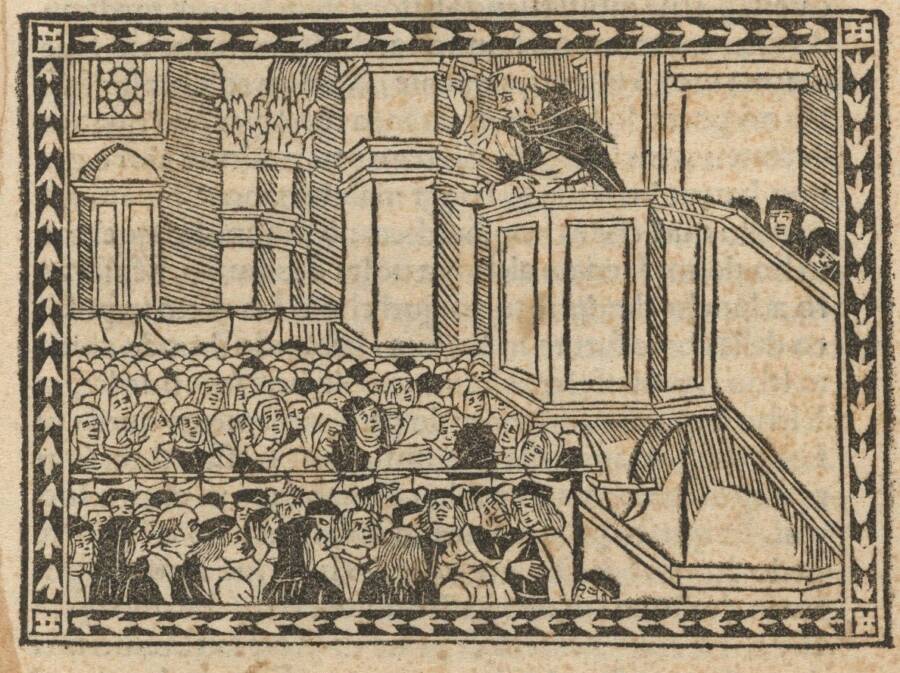
Houghton Library, Harvard University/Wikimedia CommonsA depiction of a Savonarola sermon.
Flames crackled over games and mirrors, books and statutes, leaving smoke climbing high above the Duomo.
But a powerful group had grown increasingly unhappy with Girolamo Savonarola: Pope Alexander VI and the Catholic Church. And Savonarola’s influence would soon fade like the smoke over Florence.
The Gruesome Execution Of Girolamo Savonarola
As Girolamo Savonarola consolidated power, Church leaders attempted to bring him to heel. They disliked his denunciations of luxury in the Church, and sought to silence him. At first, they attempted to do so by buying Savonarola’s loyalty. But when Pope Alexander VI tried to bribe him by making him a cardinal, Savonarola refused outright. “A red hat?” he purportedly replied. “I want a hat of blood.”
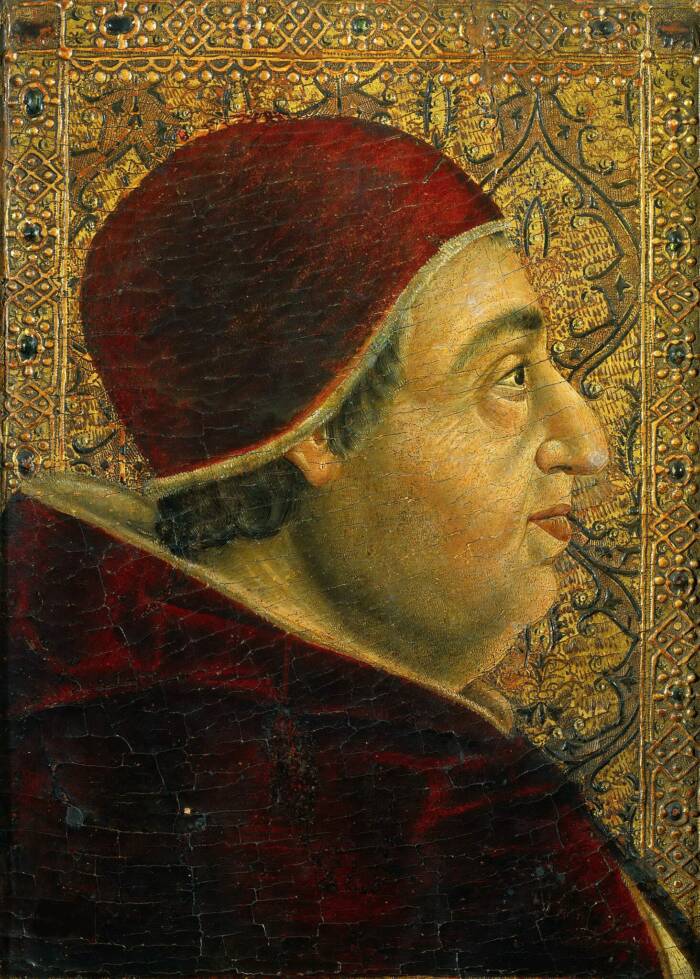
Public DomainPope Alexander VI, who ordered the excommunication and arrest of Girolamo Savonarola.
When Savonarola declared that he was a messenger from God, he sealed his fate. Alexander VI could no longer stand aside. He had the friar excommunicated and, in April 1498, Savonarola was arrested.
Brutally tortured on the rack, Savonarola confessed — then recanted. But he was nevertheless sentenced to death alongside two of his most loyal followers. The three men were condemned to be hanged over a raging fire.
“We shall have a fine bonfire,” a papal commissioner, who’d come for the execution, remarked, “for I have the sentence of condemnation with me.”
On May 23, 1498, a large crowd gathered in Piazza della Signoria, where Savonarola had held his “Bonfire of the Vanities.” As a bishop stripped Savonarola and his companions of their religious frocks, he told Savonarola “I separate thee from the church militant and from the church triumphant,” to which the friar replied, “That is beyond your power.”
A priest standing nearby purportedly asked Savonarola how he felt as he stood on the edge of death. Savonarola allegedly responded with his last words: “The Lord has suffered as much for me.”
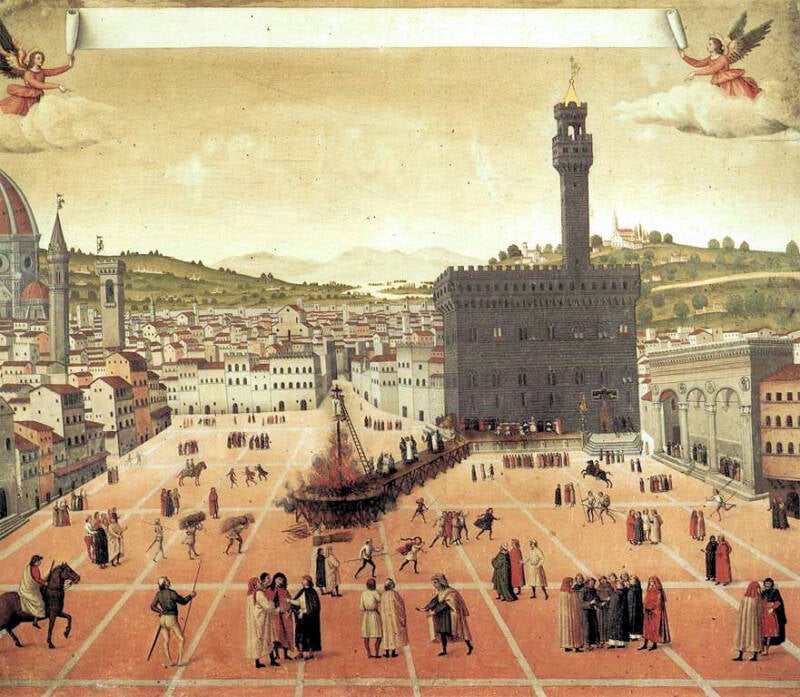
Museo di San Marco/Wikimedia CommonsA painting of Savonarola’s death and burning.
He was forced to watch the deaths of his two companions. Then, Savonarola was hanged as the fire burned beneath his feet. As he burned, someone in the crowd shouted “If you can work miracles, work one now!” and, to the horror of the crowd, Savonarola’s hand jerked up, as if in blessing.
It was just an involuntary reaction triggered by the flames. But it caused mass panic, and the crowd stampeded out of the square in terror.
In the aftermath of the friar’s gruesome death, some continued to admire Girolamo Savonarola. Niccolo Machiavelli, wrote warmly of Savonarola (though he critiqued him as well). But ultimately, Savonarola was not remembered as a savior or a saint. Rather, he’s best known as the man who’d have burned the best of Florence in the pursuit of his better angels.
After learning about Girolamo Savonarola, the friar who tried to make Florence into a Christian republic, go inside the life and death of Cesare Borgia, the son of Pope Alexander VI who tried to remake Europe. Or, discover the grisly stories behind some of the worst torture devices of the Middle Ages.





